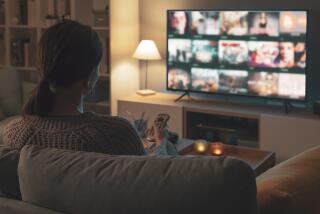TV GUIDE
- Share via
Set up rules regarding which TV programs to watch and for how long. Also, be attentive to children who might tip over television.
Parents may be concerned about how much television children watch, but here’s another danger of TV. Today’s lighter, larger TV sets seem to be easier to pull off their stands. Children, especially young children trying to climb TV stands, are being injured by falling televisions.
Some tips:
* First, place your television on the lowest shelf available. Push it back as far as it will go, and if possible anchor it to the furniture.
* Be sure drawers are always closed. Latch them if necessary.
* Think about using braces to secure furniture such as bookcases to the wall.
Here are suggestions about TV watching and children:
* Set limits on what children can watch. Homework and meals with the family take priority.
* Watch TV with your children and talk about what each of you liked and didn’t like.
* Set an example. Carefully choose programs and the amount of time you watch television.
* Make one room a TV-free zone--a comfortable place to read, talk and listen, with no television set.
* Don’t use TV as a baby-sitter.
* Encourage your children to spend their free time in activities such as sports, hobbies, playing with friends, or reading rather than sitting in front of the tube.
* Limit video games to half an hour a day. Use a kitchen timer.
* Look for TV programs that encourage kids to do something positive: Build a playhouse, start a hobby, help out at home, volunteer to help someone. Look for TV programs that relate to a book, something your child is studying, or an experience from your childhood or that of a relative.
* Don’t use TV as a reward or punishment.
* If you find a TV ad or program offensive, write or call the sponsor and the station.
Classroom TV stand dangers
* The U.S. Consumer Product Safety Commission and the International Communications Industries Assn. warns the nation’s schoolteachers not to allow children to move or play near TV or audiovisual carts because they can tip over and kill or seriously injure children.
In most of the cases, a teacher asked the young students (ranging in age from 7 to 11) to move a cart to another room. The cart overturned when it apparently hit a child’s foot while being pulled or when the child got on the front of the cart for a ride. Typically, two children were moving the audiovisual cart, one child pulling from the front and the other child pushing from the back. The child in front was the one who was injured or killed. In one recently reported incident in which the cart was not being moved, a young girl suffered permanent brain damage when she climbed on or fell onto a cart and the cart and TV fell.
*
Source: U.S. Consumer Product Safety Commission; the National Citizens’ Crime Prevention Campaign
More to Read
The complete guide to home viewing
Get Screen Gab for everything about the TV shows and streaming movies everyone’s talking about.
You may occasionally receive promotional content from the Los Angeles Times.






